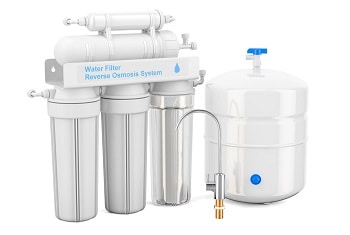You have a well, and you have decided to get a reverse osmosis drinking water system to make your well water healthier to drink. You have been concerned about there being bacteria in your well water and are not quite sure what you should do to make sure that your water is not just healthier, but also free of bacteria.
Does A Reverse Osmosis System Remove Bacteria? Because bacteria are larger than the filtering pores in a reverse osmosis membrane, it is highly effective at filtering out bacteria. But imperfections in a reverse osmosis membrane may allow bacteria to get through, so reverse osmosis alone is not 100% effective at removing bacteria from water.
Bacteria in water is a common problem, and using a reverse osmosis system to help remove bacteria from your water is a great step in the right direction, but there is more to know about removing bacteria from your water.
How does a reverse osmosis system remove bacteria?

The process of reverse osmosis uses a semi-permeable membrane to remove impurities from water. Any object that will not go through the membrane will be rejected and rinsed away.
If there are bacteria in your water, and the size of the bacteria is larger than the openings of the membrane, it will not be able to pass through, and therefore it will be removed from your water.
Over time, a reverse osmosis membrane will lose its effectiveness at filtering contaminants from your water. When this happens, it is more likely that bacteria will be able to pass through the membrane and continue through to your drinking water faucet.
What can damage a reverse osmosis membrane to make it less effective at removing bacteria?
Sediment or debris:
A reverse osmosis membrane is a semi-permeable mesh. You can think of it as a very fine screen that blocks particles that are larger than the holes in the screen. If a jagged-edged particle attempts to go through one of these holes, it could make the hole larger.
Picture a small twig poking a hole in one of the window screens on your home. Window screens are there to stop bugs from coming into your home, but if they get poked by an object, it can create a larger hole and allow bugs to get in.
This can also happen with the mesh of a reverse osmosis membrane. And when the membrane develops larger openings, larger objects like bacteria could pass through.
A reverse osmosis system will come with a sediment pre-filter, to capture debris and sediment from your water before it can get to the membrane of your reverse osmosis system.
Chlorine:
Many municipal water suppliers will use chlorine to disinfect the water that they are supplying to you. Chlorine is a corrosive substance that will eat away at the reverse osmosis membrane, making the openings larger, and even creating new holes where there should not be any.
Larger openings on a reverse osmosis membrane or openings created where there shouldn’t be any can allow bacteria to get through. But if your water has been treated with chlorine, it is not likely to contain any bacteria.
If your water contains even a small amount of chlorine, it is very important that you purchase a reverse osmosis drinking water system that has a carbon pre-filter to remove the chlorine from your water to protect your reverse osmosis membrane.
Can bacteria grow inside of a reverse osmosis system?
We like to think that the water coming from our tap or reverse osmosis faucet is pure and has not been in contact with anything harmful, but the reality of it is, bacteria can grow in all kinds of environments, including your reverse osmosis drinking water system.
For the most part, your reverse osmosis drinking water system is an enclosed system that does not allow air into it, but because your water can be exposed to oxygen before it gets to your reverse osmosis system, there can be bacteria in it that can continue to grow inside of your system.
Carbon pre-filters and post-filters are ideal places for bacteria to settle and begin multiplying. The bacteria will nestle into the pores of the carbon particles, and then reproduce, and develope a colony.
Also, any connection of a tube to fitting or one part of the reverse osmosis system that has been attached to another can have a crease or crevasse where bacteria can find its way into.
Can you remove bacteria from a reverse osmosis system?
Fortunately, you can disinfect the inside of your reverse osmosis drinking water system with a simple dose of reverse osmosis system sanitizer.
To sanitize your reverse osmosis system properly, see my article, How To Sanitize You Reverse Osmosis System.
What other ways can you remove bacteria from water?
Disinfecting your water with chlorine:
Adding chlorine to water is a very common way that water is disinfected. Water containing bacteria can be made safe to drink by adding chlorine, but the chlorine then needs to be removed from the water as well.
A carbon filter will remove chlorine from water, but using chlorine is not inconvenient, but more and more people are going away from using chemicals for treating their water.
An ultraviolet water purifier:
Using ultraviolet light to disinfect water is a very clean and simple way to remove harmful bacteria from your water before it even gets to your reverse osmosis drinking water system and your entire home.
As water passes through an ultraviolet water purifier, your water will be sanitized, making it safe to drink.
Are there reverse osmosis systems with ultraviolet purification?
Absolutely! One of my favorite reverse osmosis drinking water systems has an ultraviolet light built right into the system.
Not only can the reverse osmosis membrane remove a high percentage of bacteria from your water, but the ultraviolet light will help to disinfect your water before leaving the system.

